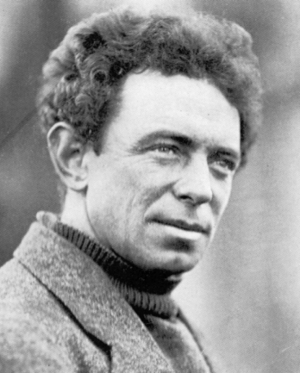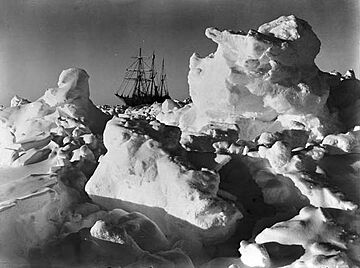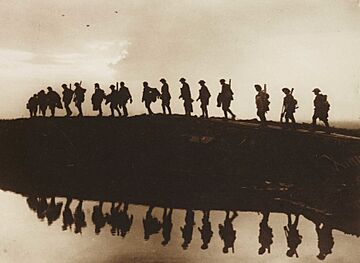Frank Hurley facts for kids
Quick facts for kids
Frank Hurley
|
|
|---|---|

Hurley around 1914
|
|
| Birth name | James Francis Hurley |
| Born | 15 October 1885 Glebe, New South Wales, Australia |
| Died | 16 January 1962 (aged 76) Collaroy Plateau, New South Wales, Australia |
| Allegiance | Australia |
| Service/ |
First Australian Imperial Force Australian Army |
| Years of service | 1917-1918, 1940 |
| Rank | Captain |
| Unit | 1st Division (Australia) |
| Battles/wars | Battle of Passchendaele and the Battle of Bardia |
| Other work | 1908–1948 |
Frank Hurley (born October 15, 1885 – died January 16, 1962) was an amazing Australian photographer and adventurer. He was known for taking incredible pictures in tough places. Frank went on many trips to Antarctica, a very cold continent. He also worked as an official photographer for Australian soldiers during both World War I and World War II.
He was the main photographer for two big Antarctic trips: the Australasian Antarctic Expedition and the Imperial Trans-Antarctic Expedition. Frank Hurley had a special artistic style. He created many memorable photos, sometimes using staged scenes or combining different pictures.
Contents
Frank Hurley's Early Life
Frank Hurley was the third of five children. His parents were Edward and Margaret Hurley. He grew up in Glebe, a suburb of Sydney, Australia. When he was 13, he ran away from home. He worked at the Lithgow steel mill for two years. Later, he returned home to study at a local technical school. He also attended science classes at the University of Sydney.
Getting Started with Photography
When Frank was 17, he bought his first camera. It was a simple Kodak Box Brownie. He paid for it little by little each week. He taught himself how to take photos. Soon, he started his own postcard business. Frank became known for taking risks to get amazing pictures. He even stood in front of a moving train to capture it on film!
Frank Hurley married Antoinette Rosalind Leighton on April 11, 1918. They had four children together. These included twin daughters, Adelie and Toni. Adelie later became a press photographer. They also had a son named Frank and a youngest daughter named Yvonne.
Adventures in Antarctica

Frank Hurley spent more than four years exploring Antarctica. When he was 23, in 1908, he heard about an expedition to Antarctica. It was being planned by Australian explorer Douglas Mawson. In 1911, a friend named Henri Mallard suggested Hurley for the job. He became the official photographer for Mawson's Australasian Antarctic Expedition.
Joining Mawson's Expedition
Hurley said in his life story that he met Mawson on a train. He talked his way into getting the job. Mawson agreed, and Hurley's friend Mallard helped. Mallard owned a Kodak store and provided the camera gear. The expedition left in 1911 and came back in 1914. When Hurley returned, he made a documentary film. It was called Home of the Blizzard. It used his footage from the trip.
Shackleton's Epic Journey
Hurley was also the official photographer for Sir Ernest Shackleton's Imperial Trans-Antarctic Expedition. This trip started in 1914. The crew became stuck in the ice until August 1916. Hurley's camera equipment for this trip was extensive. It included a film camera, a large plate camera, and smaller Kodak cameras. He also had lenses, tripods, and developing gear.
Most of this equipment had to be left behind. Their ship, Endurance, was lost in 1915. Hurley only kept a small hand-held camera. He also saved three rolls of film. For the rest of the trip, he took only 38 pictures. He also chose 120 of his glass-plate negatives to save. He had to smash about 400 others. Some of these plates are now at the State Library of New South Wales.
Hurley took many early color photos of the expedition. He used a method called the Paget process. He also took pictures in South Georgia in 1917. Later, he put his records into a film called South in 1919. His footage was also used in the 2001 IMAX movie Shackleton's Antarctic Adventure. He went back to Antarctica in 1929 and 1931. These trips were part of Mawson's British Australian and New Zealand Antarctic Research Expedition.
War Photography

In 1917, Hurley joined the Australian Imperial Force (AIF). He was an honorary captain. He took many amazing battlefield photos during the Third Battle of Ypres. Frank was very adventurous. He took big risks to photograph soldiers and battles. He also created many rare panoramic and color photos of the war.
Capturing War's Reality
Hurley kept a diary from 1917 to 1918. It described his time as a war photographer. He wrote that he wanted to show the public what soldiers did. He also wanted to show how war was fought. In October 1917, he briefly resigned. This happened when he was told not to create composite images. These are pictures made by combining several photos.
Combining photos was popular among photographers then. Hurley believed it could show the horror of war. He thought it would make his audience feel it too. His time with the AIF ended in March 1918.
For a 1918 exhibition in London, Hurley used composite images. These were large photo murals. They helped show the drama of war in a way single photos could not. This caused problems with the AIF. They said combining photos made them less truthful. Hurley wrote that he would listen to soldiers visiting his exhibitions. He found that they liked the composite photos. This made him feel they were justified. However, Charles Bean, the official war historian, called Hurley's composite images "fake."
World War II Photography
Hurley also worked as an official photographer during World War II. He led the Photographic Unit for the Australian Department of Information. He worked from September 1940 until early 1943. His base was in Cairo, Egypt. He took the only film of the first victory against the Italians. This was at Sidi Barrani in December 1940. The film was released globally by Cinesound and Movietone News.
He also covered the Battle of Bardia and the Siege of Tobruk in 1941. He photographed both battles at El Alamein in 1942. Several of his war diaries cover this time.
In early 1943, the Australian 9th Division returned to Australia. They were needed to fight Japanese forces. Hurley left his position but stayed in the Middle East. He became the Middle East Director of Army Features and Propaganda Films. This was for the British Ministry of Information. He traveled about 200,000 miles. He covered areas from Libya to Persia. He made regular items for War Pictorial News. He also made two-reel features. He photographed two important meetings of leaders in Cairo and Teheran in 1943.
Only one diary from this period still exists. It summarizes his 1943 work. It also covers a four-month trip from Cairo to Teheran in 1944. During this trip, he filmed for The Road to Russia (1944). He also filmed A Day in the Life of a King (1944). He possibly made the first film of the Marsh Arabs, Garden of Eden (1945). He also made another film about Teheran. Other films from this time include Cairo (1944) and The Holy Land (1945). Hurley returned to Australia in September 1946.
Frank Hurley's Cinematography

Frank Hurley also used a film camera to record many events. These included his Antarctic expeditions. He filmed the building of the Sydney Harbour Bridge. He also filmed the war in the Middle East during World War II. His film camera was a Debrie Parvo L 35 mm. It was a hand-crank camera made in France. This camera is now in the National Museum of Australia collection.
Hurley made several documentaries during his career. One of his most famous was Pearls and Savages (1921). He also wrote and directed dramatic feature films. These include Jungle Woman (1926) and The Hound of the Deep (1926). He also worked as a cinematographer for Cinesound Productions. His well-known film credits there include The Squatter's Daughter (1933), The Silence of Dean Maitland (1934), and Grandad Rudd (1935).
Select Films by Frank Hurley
- Dr. Mawson in the Antarctic (1913) - director
- Into Australia's Unknown (1915) - director
- Pearls and Savages (1921) - director
- Jungle Woman (1926) - director
- The Hound of the Deep (1926) - director
- Southward Ho With Mawson (1930) - director
- Siege of the South (1931) - director
- Symphony in Steel (1932) - director
- The Squatter's Daughter (1933) - cinematographer
- Strike Me Lucky (1934) - cinematographer
- Grandad Rudd (1935) - cinematographer
- Tall Timber (1937) - original story
- A Nation is Built (1937) - director
- 40,000 Horsemen (1940) - cinematographer
See also
- Photography in Australia


